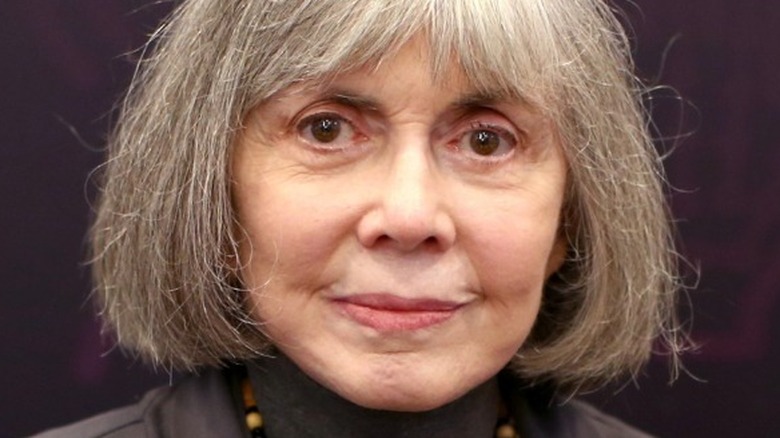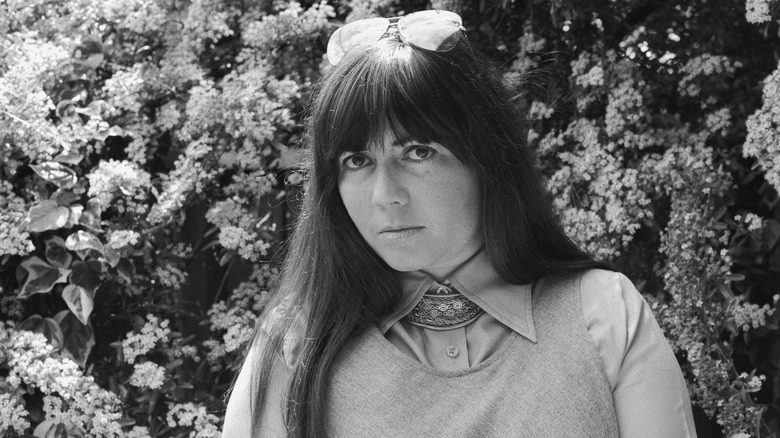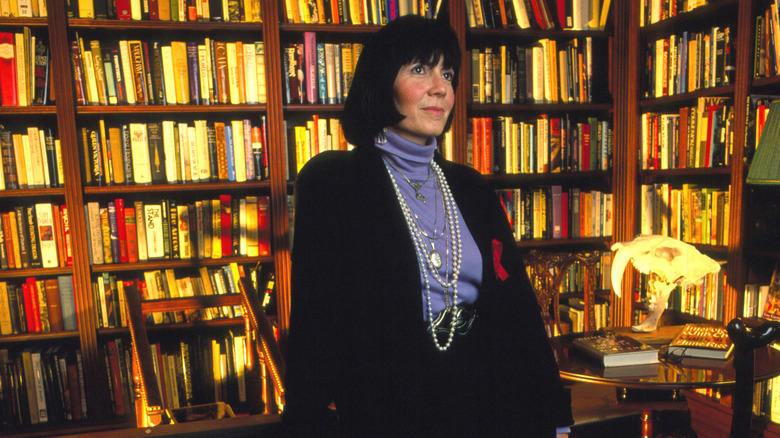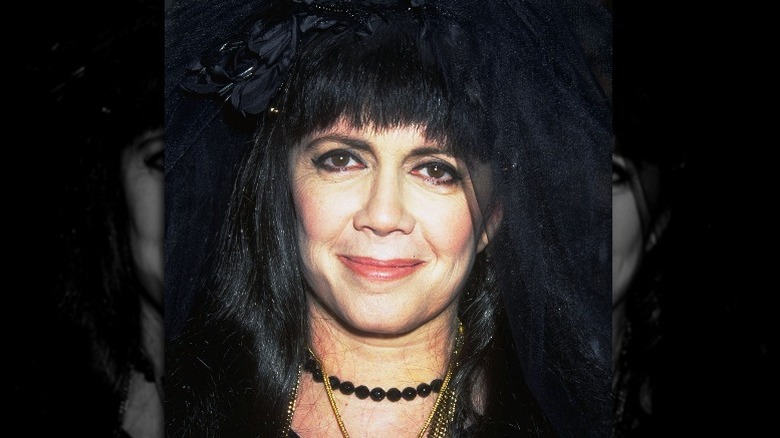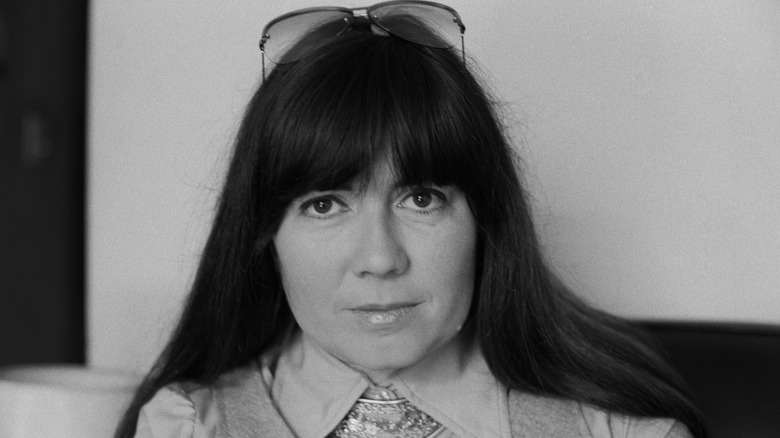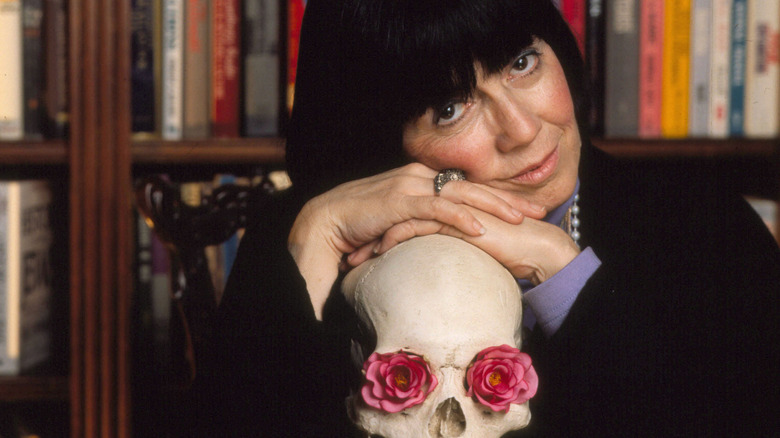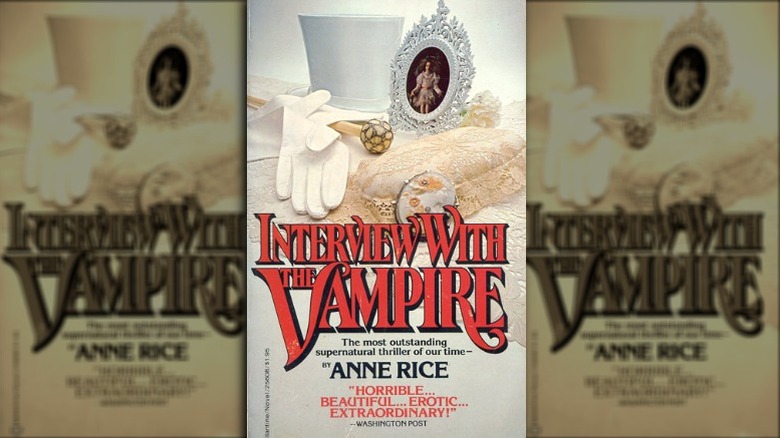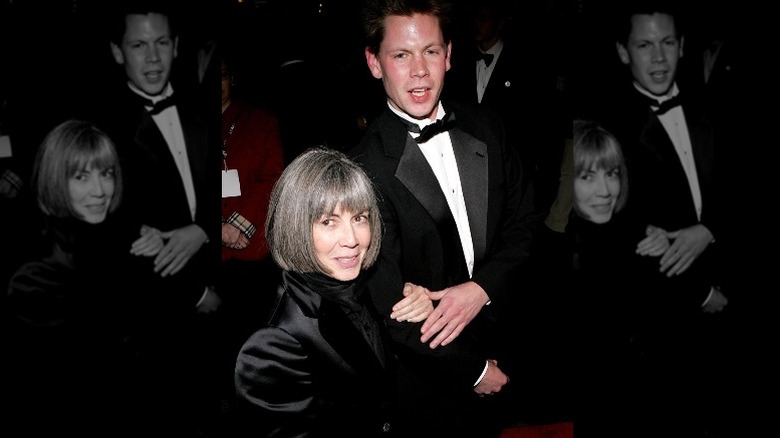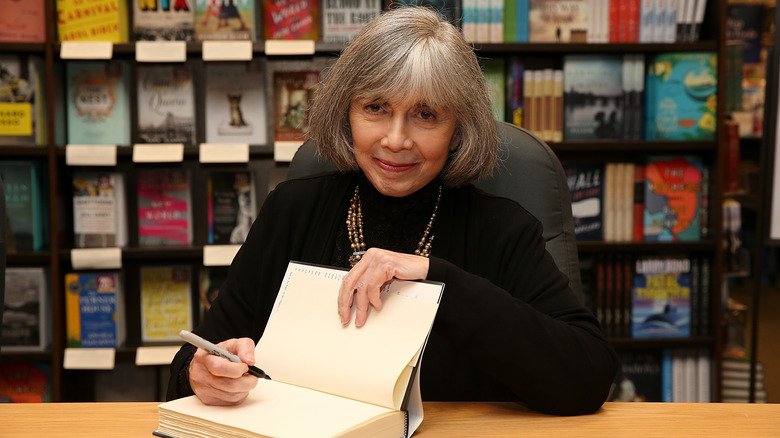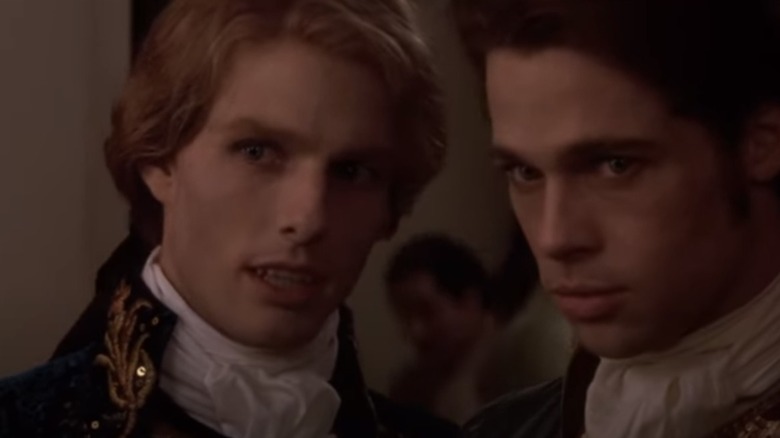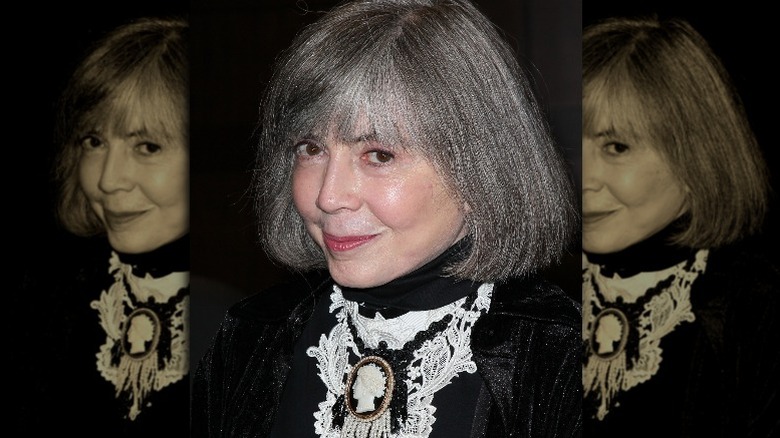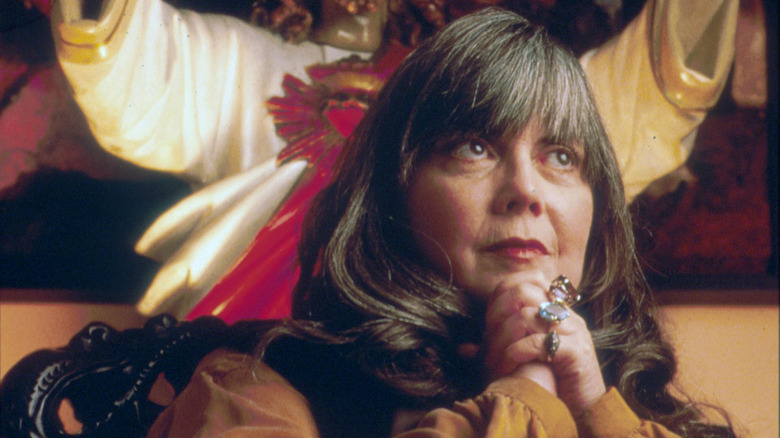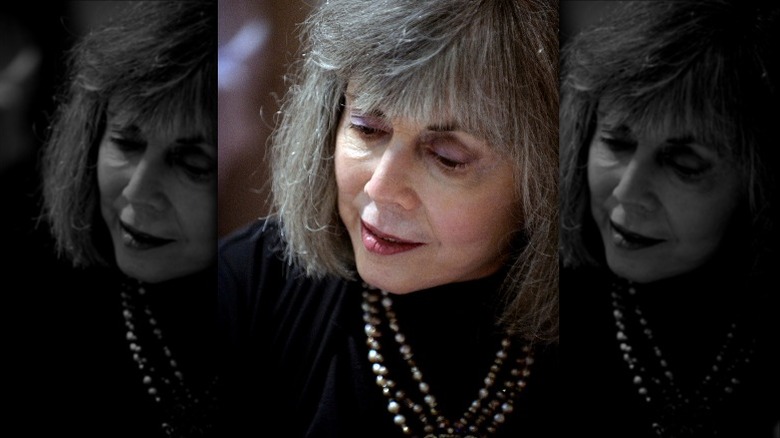The Life And Death Of Author Anne Rice
Long before Stephanie Meyer made vampires sparkle in "Twilight," Anne Rice infused the bloodsuckers of legend with emotion and a fiery sexuality that had rarely been explored in the horror genre with her 1976 debut "Interview with the Vampire." Born of grief and a problematic relationship with spirituality and religion, Rice's "Vampire Chronicles" redefined vampires in literature and film for a generation. Through extensive research of folklore and a loving respect for such classic tales as Bram Stoker's seminal masterwork "Dracula" and Sheridan Le Fanu's "Carmilla," Rice created a vampiric world with a history as rich and detailed as Tolkien's Middle Earth or H.P. Lovecraft's Cthulhu Mythos.
Although she turned her talents to other genre tropes such as ghosts, witches, and werewolves over the course of her long career, it was Lestat and his immortal brethren who truly owned Rice's heart. In 2018, she published what would be the 15th and final volume of "The Vampire Chronicles," "Blood Communion: A Tale of Prince Lestat," bringing the long, dark saga to an end. Just three years later, Rice's life also came to a close. This is her amazing real-life story.
This article addresses alcohol misuse. If you or anyone you know is struggling with addiction issues, help is available. Visit the Substance Abuse and Mental Health Services Administration website or contact SAMHSA's National Helpline at 1-800-662-HELP (4357).
Anne Rice's early life
As detailed in Katherine M. Ramsland's "Prism of the Night: A Biography of Anne Rice," Rice was born Howard Allen Frances O'Brien in New Orleans, Louisiana, on October 4, 1941, to parents Howard O'Brien and Katherine Allen O'Brien. Anne's father grew up on the tough streets of New Orleans' Irish Channel where, according to Ramsland, he learned to be tough in the face of neighborhood bullies. Taunted with chants of "Howard, Howard, little girl coward!" Rice came to think of his moniker as feminine. Consequently, he conferred it to his second daughter, much to her later consternation.
When Anne, then still called Howard by her family, enrolled in the first grade at Redemptorist School, a nun asked her name. Before her mother could answer for her, the future author of "The Vampire Lestat" blurted out, "It's Anne!" Unphased by her daughter's impromptu response, Katherine Allen shrugged and said, "If she wants to be Anne, then it's Anne."
The second of four daughters, Anne Rice inherited a sense of whimsy and a gift for storytelling from her mother. She and her sister Alice, who herself grew up to be the successful novelist Alice Borchardt, shared an elaborate fantasy life as children playing out scenarios from their imaginations as their alter-egos the Slickery children, a globetrotting group who traveled the world building castles. Rice also immersed herself in an interior fantasy life in which she imagined a number of dream worlds filled with dozens of characters and complex stories.
Alcohol misuse killed Anne Rice's mother
In 1942, Anne Rice's father joined the Navy for a 3-year enlistment. Frustrated with his job at the post office, Howard O'Brien was eager to serve his country after the bombing of Pearl Harbor. Both he and wife Katherine agreed it was the right thing to do. Left alone for the first time in her life, Katherine struggled to balance the demands of housekeeping and motherhood. In an effort to stem her loneliness, she turned to drink. As documented in "Prism of the Night," she became a binge drinker who often imbibed to excess in private.
Despite her alcoholism, Katherine was an attentive mother who instilled a respect for education, imagination, and free-thinking in her young daughters. However, she was also a strict Catholic who strongly believed in rigorous religious discipline. The dichotomy of living in a household that was both forward-thinking and religiously restrictive had some unexpected consequences for Anne when it came to her life at Redemptorist School. "I desperately wanted to fit in," she told biographer Katherine Ramsland. "We felt the other kids ridiculed us for our book reading and our vocabulary. The nuns accused us of trying to be different."
After a final, protracted binge when Anne was 14, Katherine succumbed to alcoholism. "At that point, everyone wanted that situation to end," Anne Rice recalled. "There was no hope that she'd ever stop. She was much too far gone mentally into denial ... Her world had become totally unlivable for her."
Leaving Louisiana
The death of her mother at the age of 48 had a profound impact on Anne Rice. Although she couldn't help but feel a sense of relief on one level, she was nonetheless devastated by the loss. "She gave me so many wonderful things," Anne told author Katherine Ramsland, "but above all, she gave me the belief in myself that I could do great things, that I could do anything I wanted to do. When it came to accomplishments in the world, to manner of dress, to intellectual curiosity or achievements, she gave me a sense of limitless power."
Life would go on for the grieving O'Brien family, and soon Anne's father remarried. Howard O'Brien moved his family into a small apartment. Anne, who had taken on much of her mother's responsibilities including caring for her sisters, became visibly worn-down in her grief. Now living in more crowded quarters, Howard felt the best way to relieve the pressure and take the load off of Anne was to send the girls to a boarding school. Anne hated life at St. Joseph's Academy, later claiming the experience was "like something out of 'Jane Eyre.'" Although she was used to the strictness of parochial school, the discipline enforced by the nuns of St. Joseph's was soul-crushing for the budding Bohemian.
Fortunately, her time at St. Joseph's was cut short when her father took a job in Dallas, Texas. Reluctant to leave her beloved New Orlean, Anne looked on the move with dread.
Westward migration
When Anne Rice was 16, her family settled into a new life in the Dallas suburb of Richardson, Texas. Although she would never truly feel at home in Texas, she quickly adapted to the freedom of public school. As detailed in "Prism of the Night," Anne soon attracted a group of like-minded friends with similar artistic and intellectual interests. With beatnik culture capturing the imaginations of young people across the country, Anne and her group of outsiders set themselves apart from their peers in fashion and attitude.
While at Richardson High School, Anne met and fell in love with fellow journalism student Stan Rice. Their romance, however, would have to wait. Anne, a year ahead of Stan in school, graduated and enrolled at Texas Women's University in Denton, Texas. Low on cash, she transferred to North Texas State College after her freshman year where she reconnected with Stan. Although their romance was slow to rekindle, the couple eventually became serious. As detailed by Biography, they married and made their way to San Francisco where they enrolled at San Francisco State College.
Despite her long-held literary aspirations, Anne pursued a degree in political science. "I couldn't read fast enough to pass English courses," she told biographer Katherine Ramsland, "I couldn't read Middle English at all. I was not ready to read Shakespeare at that age, and I had a great talent for research in history and political science." Meanwhile, Stan Rice majored in creative writing and was quickly establishing himself as a talented poet.
Devastating loss
With the hippie revolution exploding around her 1960s San Francisco, Anne Rice was largely out of step with the youth culture. Although she had respect for outsiders, the peace, love, and drugs movement left Rice cold. "I would have defended those people to outsiders to the death," Anne told Katherine Ramsland, author of "Prism of the Night," "but inside, I thought it was a crock. I was totally out of water with those people, all of them ... I didn't click. I was out of step, inhibited, uptight."
By 1966, Anne's husband Stan had earned a master's degree and took a teaching position at San Francisco State University. Anne pursued graduate studies at San Francisco State, and on September 21, 1966, gave birth to a daughter. The Rices named the child Michele. Nicknamed "Mouse," Michele grew to be a beautiful, precocious child.
As Stan Rice's career bloomed, Anne continued her academic pursuits and tentatively began writing. Sadly, life was about to deal her a devastating blow. In 1970, 4-year-old Michele began complaining of an illness. She was feverish and too tired to play. Instinctively feeling that her daughter was seriously ill, Anne took Michele to the doctor, who diagnosed the child with acute granulocytic leukemia. Despite numerous hospital stays and rounds of chemotherapy, Michele died on August 3, 1972. With the death of their beloved child, the Rices descended into depression. Drinking heavily, they withdrew from life, blaming themselves for Michele's disease and death.
Interview with the Vampire and success
In a 1993 interview, Anne Rice explained that after her move to California, she became obsessed with her childhood home of New Orleans. Fascinated by the city's history, she spent hours in research at the Berkeley library. However, Rice didn't know that a semi-abandoned short story called "Interview with the Vampire" would be the gateway through which she would bring her love of the Crescent City to the world and, in turn, catapult her to worldwide fame.
"It was almost an accident," Rice said. "It started as a short story. I just wrote it one night thinking what it would be like to get a vampire to really, really tell you what it was like to drink human blood –- to take human life. Was it a sacramental thing?"
Nine months after her daughter Michele's death, Rice returned to the story and began expanding the concept into a full-length novel. With her imagination racing, she envisioned a vampiric family of sorts: the brooding Louis who struggles with his undeath, the haughty and amoral Lestat, and the tragic Claudia, the physical image of Rice's late daughter, forever trapped in the body of a child. After numerous rejections, Rice sold the novel to publisher Alfred A. Knopf with an unheard-of advance for hardcover rights of $12,000. At 34, Rice was at last a published author. However, the good news did little to quell her grief for Michele which manifested in alcoholism and crippling obsessive-compulsive disorder.
Beating the bottle
For much of her life, Anne Rice considered alcohol her drug of choice. To Anne, drinking was a social lubricant. It was also a way for her and her husband Stan to numb their grief. As documented in "Prism of the Night," in the years since Michele's death, Anne had tried numerous times to quit drinking with no success. Stan Rice initially didn't share his wife's determination to kick the habit. With a heavy drinker in the home, alcohol was ever-present, and the author's attempts at getting sober repeatedly failed. However, the literary couple soon had a common reason to quit.
In 1977, Anne became pregnant again. On March 11, 1978, she gave birth to a son whom she and her husband named Christopher. Agreeing that alcohol had outlived its usefulness in their creative lives, Anne and Stan pledged to completely abstain from alcohol on May 31, 1979, for their health and for the sake of their son.
In a 2008 YouTube message to her fans celebrating 28 years of sobriety, Anne Rice offered a single piece of advice: "Don't Drink." "For years, I was an episodic drunk. After a considerable length of time, I became what I would call a steady drunk," she explained. "...I wrote 'Interview with the Vampire' and got drunk at night ... I don't know that I'd be alive today if I kept going the way I was going ... but something saved me. It was a miracle. And the name of that miracle was Christopher Rice."
The queen of Gothic fiction
"Interview with the Vampire" quickly struck a chord in the popular literary world. As documented in "Prism of the Night," paperback rights for the novel sold for an astonishing $700,000. Hollywood also came calling with movie studio Paramount Pictures paying Rice $150,000 with an escalation clause bumping the sum to $250,000. Anne Rice's writing also impressed the critics, with The Philadelphia Inquirer calling the book a "supernatural thriller raised to the level of literature."
Rice followed "Interview with the Vampire" with the historical novels "The Feast of All Saints" in 1979 and "Cry to Heaven" in 1982. However, they failed to live up to "Interview with the Vampire's" success. However, the author struck gold again with the 1985 publication of "The Vampire Lestat." Focusing on Lestat de Lioncourt, one of "Interview with the Vampire's" most compelling characters, the novel put the events of the previous book in a new context and provided readers with a complex origin story for the vampire race. Debuting at number nine, "The Vampire Lestat" occupied the New York Times Best Seller List for six weeks. More importantly, the novel cemented Rice's reputation as a writer of Gothic horror and marked the beginning of her popular "Vampire Chronicles" series of books.
Over the course of her career, Rice turned to other supernatural themes including witches in her "Lives of the Mayfair Witches" trilogy, werewolves in the books "The Wolf Gift" and "The Wolves of Midwinter," and ghosts in the standalone novel "Violin."
Anne Rice versus Hollywood
Although the movie rights for "Interview with the Vampire" sold just prior to the novel's publication in 1976, bringing the first story of Anne Rice's "Vampire Chronicles" to the screen proved a long and arduous process. For nearly two decades, the project was shuffled from studio to studio before winding up in the hands of Geffen and Warner Brothers in 1994.
Although Rice was an avowed movie lover, her relationship with Hollywood was often problematic. In a 1994 interview included in "The Unauthorized Anne Rice Companion," writer Martha Frankel quotes Rice as having said: "You can't imagine how much I despise Hollywood producers and the studio system and many of the people there ... They will kill you." From the beginning, the film adaptation of her first novel seemed to fall short of the author's vision. Among her first choices for director were Ridley Scott and David Cronenberg. Geffen, however, went with Neil Jordan who was riding high on the critical success of his 1992 drama "The Crying Game." Still, as detailed by "Imagi-Movies," Rice and Jordan clashed over screenwriting credit.
The casting of Tom Cruise as her beloved Lestat caused a public uproar. To the studio's frustration, Rice publicly criticized the choice to place Cruise in the role of "the Brat Prince" as "impossible to imagine." Yet, upon the film's release, Rice became one of Cruise's biggest champions, praising his performance as "courageous" in a public statement to her fans printed in Variety and the Advocate.
The battle of New Orleans
Anne Rice's passion for New Orleans and its rich history, culture, and architecture was legendary. The Big Easy figured prominently in both her fiction and her personal life, and as a famous restaurateur found out, Rice's wrath came down swiftly on anybody who defiled her beloved city.
In February 1997, Rice took out a full-page ad criticizing Popeyes Chicken founder Al Copeland's St. Charles Avenue fine dining establishment Straya as a blight on New Orleans' historic cityscape in the Times-Picayune. "The humblest flophouse on this strip of St. Charles Avenue has more dignity than Mr. Copeland's structure," Rice wrote. As reported by Time, Copeland responded in kind with his own ad. The war of words escalated until Copeland attempted to sue Rice for defamation. Citing Rice's constitutional right to free speech, New Orleans' Civil District Court Judge Robin Giarrusso tossed out the suit.
Straya closed its doors in 2000.
Anne Rice's complicated relationship with religion
As documented in Anne Rice's memoir "Called Out of Darkness: A Spiritual Confession," the author quietly returned to her childhood faith in 1998 after decades of considering herself an atheist. In 2002, she went a step further and committed herself to writing only works that celebrated her restored belief. She published two novels about the youth of Jesus: "Christ the Lord: Out of Egypt" and "Christ the Lord: The Road to Cana," in 2005 and 2008.
Yet, Rice's newfound devotion to the Catholic Church was short-lived. Frustrated with the Church's stance on issues close to her heart, she remained a believer but left organized religion behind. "I read scripture every day of my life," Rice told CNN. "I can't find a basis there for most of the stands that churches and denominations take today on civil rights of gay people, on women and reproductive rights, [and] on the questions of how you vote in our society."
Death comes for Anne Rice
As reported by The New York Times, Anne Rice died at a Rancho Mirage, California hospital on December 11, 2021. Felled by complications from a stroke, the author was 80 years old at the time of her death.
Noting that his mother died nearly 19 years to the day after her husband Stan died of brain cancer, Anne's son, novelist Christopher Rice took to social media the following day to break the sad news to the author's many fans. "As my mother, her support for me was unconditional," Christopher Rice states. "She taught me to embrace my dreams, reject conformity, and challenge the dark voices of fear and self-doubt. As a writer, she taught me to defy genre boundaries and surrender to my obsessive passions."
Anne Rice's son also indicated that his mother, who had been living in California since 2005, would be interred in the family's mausoleum at New Orleans's historic Metairie Cemetery.
